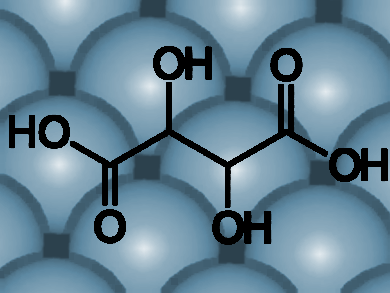Tartaric acid has a long chemical history. As a natural product found in grapes and other plants it is formed during winemaking. In 1832, Jean Baptiste Biot saw that crystals of the compound could rotate the plane of polarized light, but it was Louis Pasteur who teased apart crystals of potassium sodium tartrate to show that some were left-handed and others right-handed in 1847. He was first to produce a pure sample of levotartaric acid, you could say this was the first enantiomeric success.
Chirality, molecular handedness is critical to many chemical reactions and particularly those involving biological molecules because interactions with proteins, nucleic acids and other systems, themselves all chiral, will commonly work with just one handed form of a chiral molecule and not the other. Making pharmaceuticals, agrochemicals, and other compounds in just one of their two possible chiral forms rather than splitting yield 50:50 between active and inactive versions is an important goal of organic synthesis. As such the development of chiral catalysts is important.
A Big Hand for an Old Friend
Now, a team has shown that our old friend tartaric acid can be used as a chiral template to modify a specific surface of a copper catalyst. This might not only open the door to an improved understanding of chirality itself but lead to a new way to build active catalysts for the synthesis of single enantiomer products.
Andrew Therrien, Timothy Lawton, Brian Mernoff, Felicia Lucci, and Charles Sykes of Tufts University in Medford, Massachusetts, and Vladimir Pushkarev and Andrew Gellman of Carnegie Mellon University in Pittsburgh, PA, USA, suggest that advances in enantiospecific self-assembly, adsorption, and catalysis will be useful in biosensors, the food industry, as well as pharmaceutical and agricultural applications. There have been various attempts at surface engineering an enantioselective adsorbent or catalyst. Indeed, tartaric acid has been studied as a chiral modifier of Cu(110) surfaces [1, 2].
Kinetic News
The team has observed intriguing kinetics in what is referred to as a surface explosion of this compound on the 111 facet of copper for the first time, although earlier work from others [3, 4] has been reported on the 110 facet. In this process, increasing the temperature leads to the decomposition of the tartaric acid through a vacancy mediated autocatalytic process. This imposes a hexagonal, chiral pattern in the surface, which the team suggests might be exploited in enantiospecific surface chemistry. The team tracked the whole process with scanning tunneling microscopy and point out that quite bizarrely these systems retain a memory of earlier heat treatments.
Hexagonal Muse
The decomposition of R,R-tartaric acid they followed is different from previous surface explosions and it is the formation of the hexagonal structure on the copper that seems to drive this. The team points out that tartaric acid actually forms several different complex chiral configurations. At sufficiently high coverage a structure comprising chiral nano-pores forms, although the decomposition kinetics is always the same irrespective of the coverage – a phenomenon that has not been reported before. “In terms of novelty, the very open hexagonal chiral template that forms just before the surface explosion goes against the current thinking that very dense layers are responsible for the explosive kinetics seen in other systems”, Charles Sykes says.
Sykes told ChemViews magazine that the next step in this research will be to look for an explanation as to how flat non-chiral surfaces appear able to amplify the enantiomeric excess of gas phase mixtures of enantiomers as they adsorb on a surface.
“This is an exciting, surprising and significant observation in relation to the targeted design of chiral surfaces for enantioselective catalysis reactions,” Peter McBreen of Université Laval in Quebec, Canada, told ChemViews Magazine. “Researchers in the area widely believe that templates of chiral molecules on a metal surface would make highly selective catalysts because the reactant could only occupy the chiral spaces created by the template. Yet, this structure, revealing chiral pores, was never seen before. This indicates that studies of tartaric acid on surfaces have future surprises in store”, thinks McBreen.
- Chiral nanoscale pores created during the surface explosion of tartaric acid on Cu(111),
A. J. Therrien, T. J. Lawton, B. Mernoff, F. R. Lucci, V. V. Pushkarev, A. J. Gellman, E. C. H. Sykes,
Chem. Commun. 2016.
DOI: 10.1039/c6cc05820e
[1] M. Ortega Lorenzo, C. J. Baddeley, C. Muryn, R. Raval, Extended surface chirality from supramolecular assemblies of adsorbed chiral molecules, Nature 2000, 404, 376–379. DOI: 10.1038/35006031
[2] M. Ortega Lorenzo, S. Haq, T. Bertrams , P. Murray, R. Raval, C. J. Baddeley, Creating Chiral Surfaces for Enantioselective Heterogeneous Catalysis: R,R-Tartaric Acid on Cu(110), J. Phys. Chem. B 1999, 103, 10661–10669. DOI: 10.1021/jp992188i
[2] Bahar Behzadi, Sara Romer, Roman Fasel, Karl-Heinz Ernst, Chiral Recognition in Surface Explosion, J. Am. Chem. Soc. 2004, 126, 9176–9177. DOI: 10.1021/ja048206d
[4] Sara Romer, Bahar Behzadi, Roman Fasel, Karl-Heinz Ernst, Homochiral Conglomerates and Racemic Crystals in Two Dimensions: Tartaric Acid on Cu(110), Chem. Eur. J. 2005, 11, 4149–4154. DOI: 10.1002/chem.200400962




